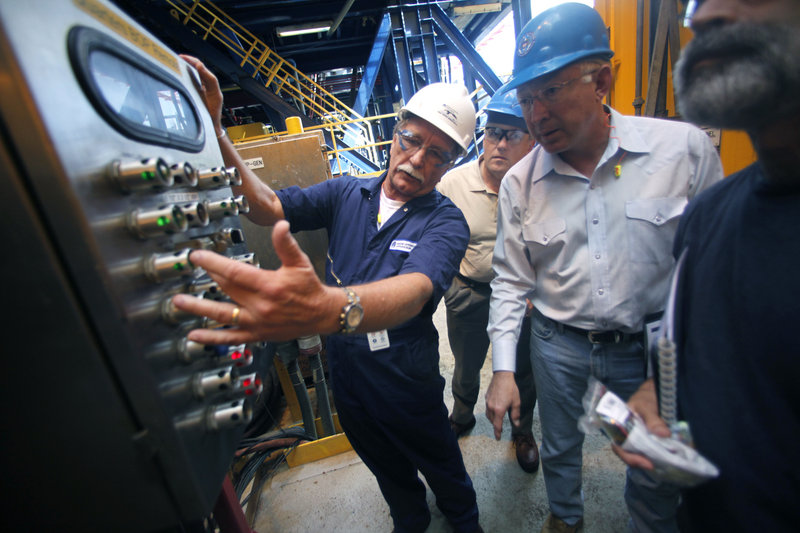ON THE GULF OF MEXICO – The helicopter passes over the blue waters of the Gulf of Mexico — with surprisingly little oil visible on its surface — when out of the sea rises a skyscraper-like structure nearly 350 feet above the waves. The $600 million rig, nearly 100 miles off Louisiana’s coast, has a hull larger than a football field and can drill more than 5 miles beneath the ocean floor.
But the gleaming new rig sits idle, shut down by the government’s freeze on drilling at 33 ocean wells.
Interior Secretary Ken Salazar visited the colossal structure last week while on a tour of three offshore oil rigs. It was his most extensive tour since the April 20 explosion of the Deepwater Horizon rig led to one of the largest environmental disasters in U.S. history and the unprecedented shutdown of offshore drilling.
Salazar told reporters who accompanied him on the trip that he’s gathering information to decide whether to revise or even lift the ban, which is scheduled to last until Nov. 30.
‘PUNISHING THE WHOLE CLASS’
Business groups and Gulf Coast political leaders say the shutdown is crippling the oil and gas industry and costing thousands of jobs, even aboard rigs not operated by BP PLC, which is responsible for the Gulf disaster.
The freeze “is like punishing the whole class” when a student does something wrong, oil executive John Breed told Salazar during a tour of the Noble Danny Adkins, one of the rigs Salazar visited Wednesday.
Salazar told the AP he believes the industry-wide moratorium imposed after BP’s Gulf oil spill was the correct call.
“I think we’re in the right direction,” he said, adding that the ultimate goal is to allow deep-water operations to resume safely. “We’re not there yet,” he said.
“I’ve got a lot of questions about drilling safety,” Salazar said. “I learned a lot about the different kinds of rigs out there — the different limitations in terms of (water) depth and equipment and the different zones of risk. It’s a complex question.”
Texas-based Noble Drilling Services Inc., which owns the idle rig, said the company and rig operator Shell have top-notch safety records, unlike BP. Congressional investigators revealed last month that BP had 760 safety violations in the past five years, while no other major oil company had more than eight.
AN IMPASSIONED PLEA
Salazar acknowledged that the freeze was causing hardship, but he said his job was to protect the public and the environment even as he supports domestic energy production.
“We’re here because we take what you’re doing very seriously, and we will do the right thing,” he told oil executives at his first stop, a deep-water production rig run by Arkansas-based Murphy Exploration & Production Co.
The Front Runner rig, owned by Houston-based Nabors Offshore Corp., operates in 3,300 feet of water 92 miles off the Louisiana coast.
At a briefing with Salazar, executives made an impassioned plea, citing the rig’s safety record. The Front Runner has been producing oil since December 2004 with no major incidents, said Nabors President Jerry Shanklin and David Harris, Murphy’s general manager of worldwide drilling.
One reason: The rig’s blowout preventer — the device that failed spectacularly in the Deepwater Horizon explosion — is above the surface, accessible to workers and easier to inspect and repair. The blowout preventer on the Deepwater Horizon — the safety device of last-resort — was on the sea floor, a mile below the surface, a common practice on exploratory wells.
While production continues on the Front Runner, two wells the company had been digging have been suspended because of the moratorium.
Resuming operations on the wells could double the rig’s production with little safety risk because the wells are being drilled into producing reservoirs where important geological information is already known, Harris said.
Harris asked Salazar to lift the moratorium for rigs such as his, which have blowout preventers on the surface.
“So you can guarantee me there will be no blowouts?” Salazar countered. “We are not going to have another oil spill like the one we are still dealing with out here at the Macondo well” operated by BP.
NO GUARANTEES
Harris and other officials stressed the redundancies built into the rig’s design — a series of backup systems meant to ensure the blowout preventer works in case of disaster.
Yet pressed by Salazar, James Hunter, Murphy’s general manager for field development and facilities engineering, finally conceded that, no, he could not make such a guarantee. Salazar beamed.
At the next site, the Noble Danny Adkins, Salazar was more like a talk-show host, asking rig officials dozens of questions.
“Tell us a story,” he said at one point.
A flat-screen TV in the rig’s galley shows a continuous loop of family photos submitted by the crew — a reminder of why safety is so important, said Breed, the Noble spokesman.
David Loeb, Shell’s top manager of floating operations in the Gulf, told Salazar his commitment to safety is personal.
“I’ve got a family. I like the beach. I like to fish,” he said. “I’ll be danged if I do anything to mess that up.”
Send questions/comments to the editors.



Success. Please wait for the page to reload. If the page does not reload within 5 seconds, please refresh the page.
Enter your email and password to access comments.
Hi, to comment on stories you must . This profile is in addition to your subscription and website login.
Already have a commenting profile? .
Invalid username/password.
Please check your email to confirm and complete your registration.
Only subscribers are eligible to post comments. Please subscribe or login first for digital access. Here’s why.
Use the form below to reset your password. When you've submitted your account email, we will send an email with a reset code.